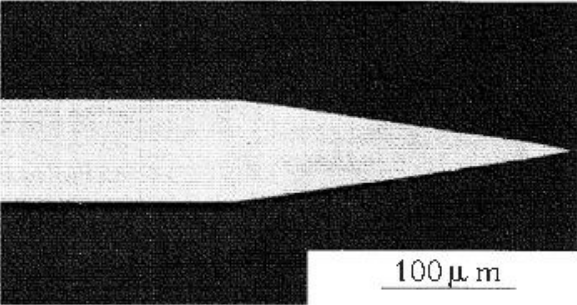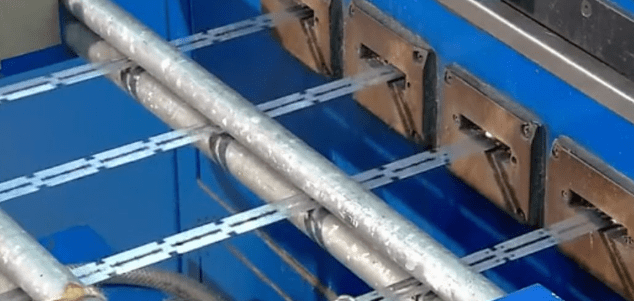
- English
- Español
- Português
- русский
- Français
- 日本語
- Deutsch
- tiếng Việt
- Italiano
- Nederlands
- ภาษาไทย
- Polski
- 한국어
- Svenska
- magyar
- Malay
- বাংলা ভাষার
- Dansk
- Suomi
- हिन्दी
- Pilipino
- Türkçe
- Gaeilge
- العربية
- Indonesia
- Norsk
- تمل
- český
- ελληνικά
- український
- Javanese
- فارسی
- தமிழ்
- తెలుగు
- नेपाली
- Burmese
- български
- ລາວ
- Latine
- Қазақша
- Euskal
- Azərbaycan
- Slovenský jazyk
- Македонски
- Lietuvos
- Eesti Keel
- Română
- Slovenski
- मराठी
- Srpski језик
Stamping product introduction - the manufacturing process of razor blades and its key steps
2024-08-14
How are the razor blades commonly used in daily life produced?
It needs to go through more than a dozen processes, and each process must be strictly handled before the 0.1mm stainless steel sheet can be ground into an extremely sharp finished product.
1. Manufacturing process of blades
The basic manufacturing steps of razor blades are as follows:
Material stamping - quenching - tempering - rough grinding - fine grinding - fine grinding - polishing - inspection - cleaning - chrome plating - soaking - drying - packaging.
2. Key links of razor blades
Every step in blade manufacturing is important. For example, the punching model, the quenching temperature, the blade grinding angle, and even the packaging are extremely important because the cutting edge cannot be damaged. Among these steps, four of them are extremely critical and determine the final quality of the blade —— durability, sharpness, and comfort.
① Raw materials
The material of the general razor blade is mainly made of 3Cr13 and 4Cr13 martensitic stainless steel. After precision processing, it is rolled into 0.3/0.4mm stainless steel sheets, divided into strips, and finally processed before the blade can be used. Steel strips are distinguished by carbon content. High-quality blades on the market are all made of 6Gr13 stainless steel. Blades made of high-quality stainless steel strips have better stability, which means that under the same conditions, they can withstand the test better.
② Heat treatment
Heat treatment is often called quenching, which is a treatment method of subjecting an object to high temperature and then cooling it. The production of ancient swords also improved the hardness and flexibility of weapons through quenching. After heat treatment, the blade not only has a higher hardness of 760-780, but also its mirror structure becomes uniform and delicate. Whether the blade is brittle or not depends on the quenching process.
The blade section of the commercially available razor blade after decomposition is shown in Figure 1 (a), and the microstructure is shown in Figure 1 (b). As can be seen from Figure 1, the edge of the razor blade is processed into a very sharp shape, and its internal microstructure is a martensite matrix with fine spherical carbides dispersed.
(a) Blade section



(b) Microstructure
Two questions: Why is the blade so hard when it is so thin? Is the blade sharpened or heat treated first? The second question has been answered in the above discussion.
The thickness of the stainless steel strip used for razors is only 1mm. It is first cut into the shape of a blade by a press. At this time, the blade is as soft as paper. Then it is heat treated, cryogenically treated, tempered, then sharpened, quality tested, cleaned, and finally coated, strength tested, anti-rust treated, packaged, etc.
For razor blade steel, it is very important to control the impurity elements that have a harmful effect on the sharpness and durability of the razor blade to an extremely low level. It is very important to comprehensively match the various required properties of razor blade steel, so in the manufacturing process of razor blade steel, not only the main elements such as carbon and chromium must be strictly controlled, but also the impurity elements must be strictly controlled.
In fact, in the production process of blades, there are strict inspection procedures, and each link has corresponding inspection standards. In particular, the sharpness test of the blade is the most intuitive and convincing.
In addition, in the heat treatment link, the famous Swiss Army Knife, Zwilling Kitchen Knife and Gillette's razor blades give consumers an intuitive feeling of durability, and these products have all been cryogenically treated.
Everyone has their own standards and requirements. Whether to use high-quality steel or general steel, whether the exit standards are strict or not, it cannot be seen in the short term, and consumers will vote with their feet in the long term.



